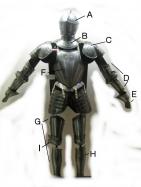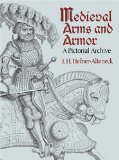 |
||||
 |
A look at the Armor of Knights
There are three main factors in the development of armor over the centuries. First is that of the metals and metal working skills available at the time. Second is the weapons that were available at the time. And third was money. Armor costs money and the more armor the more money. And of course the better the armor the more money! So, let's cover the armor of knights and we will start around the 5th century.
And a well equipped knight might have chainmail like our knight is wearing here. Chainmail was an amazing development in armor. It was very effective against slashing weapons and it could safely stop the arrows of the time.
And, impact weapons like hammers were effective against chainmail. Things did change, armor adapted to these changes.
Right up until the 13th Century the chain mail was the major component of armor for the knight. But it did evolve over that time. To soften the blow of impact weapons various things were added either over it or under it. Things like boiled leather clothing or woven gambesons which were a thick quilt-like article of clothing. And toward the end of this period a thing called scale was also added to it. Scale is a type of armor that is composed of small segments of metal that overlap each other - much like the scales of a snake. This proved to be an effective addition to chain mail.
The lower picture shows something called Lamellar. It was composed of a series of larger plates tied close together by leather thongs. Part of the reason for these developments were that they helped in effectively armoring the knight. But they were composed of small segments because of limitations in blacksmithing and metal working.
PLATE ARMOR
Then around the 11th century the first plates of armor made their appearance. They became pretty much standard in the 13th century. This plate armor is what we think of when we think about a knight in a suit of armor. The armorers craft had grown and developed to the point where complete suits of armor could be custom made for knights to wear. The Development of the Curve
I also have a larger picture showing some of the more common parts of a knights armor You can see that larger picture here. It includes descriptions of the various parts of the armor. .
I have lots of interesting articles about knights, their weapons and their organizations right here: Articles about Knights
This handsome archive depicts richly detailed armor and weaponry dating from the early ninth century to the mid-1700s. Adapted from decorative ornamentation on burial monuments and manuscripts, hundreds of finely executed images depict authentic shields, swords, crossbows, helmets, and ornate suits of body armor for knights and their steeds. 100 black-and-white plates.
|

Custom Search
|
||
Copyright©2007-2014 Kalif Publishing - All Rights Reserved | sitemap | xml sitemap |
||||
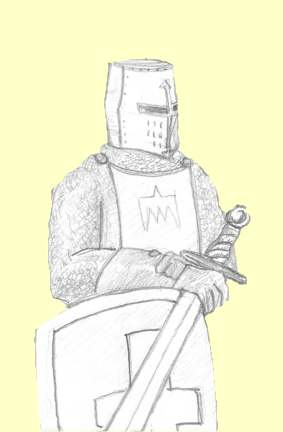
 Around the 5th century this was some pretty common armor of the knight. It was predominantly wood and leather like the helmet and the shield. Possibly it had Iron banding to make it stronger.
Around the 5th century this was some pretty common armor of the knight. It was predominantly wood and leather like the helmet and the shield. Possibly it had Iron banding to make it stronger. 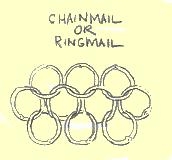 Although, chainmail did have its deficiences. When crossbows started to come into use the chainmail was not effective because the power of the crossbow could get a bolt to go right through the chains.
Although, chainmail did have its deficiences. When crossbows started to come into use the chainmail was not effective because the power of the crossbow could get a bolt to go right through the chains. 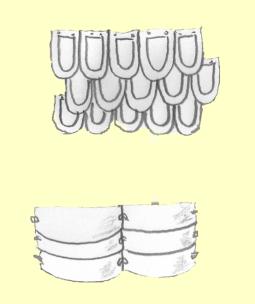 This picture shows two of the developments in armor. On the top is scale mail It was composed of many small plates of metal stitched to a base of leather or cloth and worn, sometimes over the chainmail.
This picture shows two of the developments in armor. On the top is scale mail It was composed of many small plates of metal stitched to a base of leather or cloth and worn, sometimes over the chainmail. 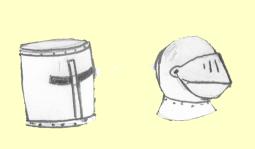 This sounds funny but one of the most important concepts in armor is that of the curve! And as blacksmiths gained the ability to curve metal they greatly improved the protective value of armor. You see, the curve, enables armor to glance blows and redirect the energy of a blow. This can be easily seen in the development of helmets throughout the centuries they started out as very crude cylinders and developed into very round and curved objects of armor. The picture here of two helmets shows this very well. The curved helmet on the right is much more effective at deflecting the blows of an opponent. But it took a lot more armor making skill to achieve something like this.
This sounds funny but one of the most important concepts in armor is that of the curve! And as blacksmiths gained the ability to curve metal they greatly improved the protective value of armor. You see, the curve, enables armor to glance blows and redirect the energy of a blow. This can be easily seen in the development of helmets throughout the centuries they started out as very crude cylinders and developed into very round and curved objects of armor. The picture here of two helmets shows this very well. The curved helmet on the right is much more effective at deflecting the blows of an opponent. But it took a lot more armor making skill to achieve something like this.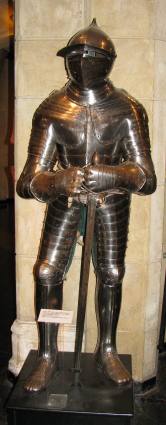 Here is a great example of a full suit of armor.
Here is a great example of a full suit of armor.